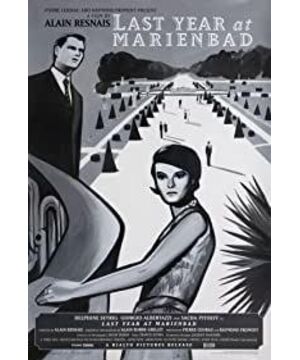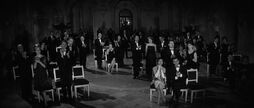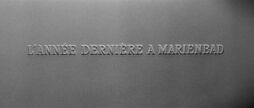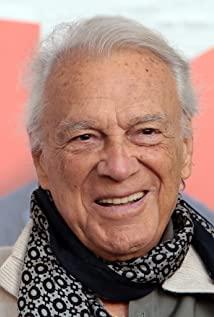(2) synchronous movement. Does this indicate two kinds of cognition: cognition of self and time.
Cognition of the relationship between self, society and the world .
Repeating elements: (1) Lines: "It must have happened in 1928 or 1929" "Please leave me alone" "
All doors are open" "I don't remember myself", the male lead's Monologue...
(2) Images: mirrors, doors, gardens, laughter, playing cards and bamboo stick games, statues, paintings,
men The main support to the camera The relationship between sound and picture in
two kinds of memories: sound dominates action, and sound and action are synchronized.
Several overlaps and overlaps: monologue and dialogue, memory and reality
The so-called story film and writer's film, or the main difference between commercial film and literary film, I personally think it is the introversion of emotions, the authorization of shots, and the alienation of narrative. . It defamiliarizes a familiar story into a non-stylized and facialized narrative, breaking the traditional and classical drama logic, and is non-modal in terms of movement, editing, and language. It can also be said that the director is the central axis of the authored film. Make the film literary. Most of the French New Wave directors accepted the influence of Surrealism. For example, Bunuel's "A Budaloo Dog" was deeply influenced by Dali's paintings.
At that time, various schools of thought in the West contended, especially the psychoanalytic theories of Symbolism, Surrealism, and Freud, which had a wide range of influences. The contribution of Freud's psychoanalytic theory in literature and film can be described as indisputable. This "Last Year in Marienbad" especially maximizes the dream-like emotion, while interspersed with the film narrative technique of stream of consciousness.
The first is time processing. The three tenses of past, present and future coexist. But the author makes it impossible for the audience to fully clarify the nodes of the time interruption. The man X and the heroine A met at a banquet. X kept evoking the memories of A's long acquaintance, while A kept rejecting or escaping to deny the memories. The camera switches back and forth, and the boundaries between memory and reality are blurred. We can't tell whether the heroine has actually seen the hero, or whether what the hero said is true. In the past, the heroine was constantly denied by the heroine in a way of escaping, while the heroine kept reminding the heroine like chasing after him. The shots switch seamlessly between memory and reality, and the director overlaps and splices different tenses, layering the narrative process. In the first second, the female protagonist is dressed in white in the memory of the male protagonist, and the next second she returns to reality and talks to the male protagonist in black attire. This kind of unpredictable scene editing is very subjective: maybe this is the memory of the male protagonist, or maybe this is just the idea that the director wants to express to the audience. In addition, at the beginning of the film, there is an obvious difference between the behavior and the sound of the characters in the film. One is the synchronization of the sound and the picture, and the other is that the sound dominates the actions of the characters on the screen. The sense of alienation brought about by the synchronization and separation of sounds also adds to the ambiguity of reality. It further blurs the line between reality and fiction.
Next is the narrative. The ambiguity and deception of language are brought into full play. Most of the lines in the film come from male monologues and male and female dialogues. In the episode where the man convinces the woman that the two met last year, the lines are interwoven with monologues and dialogue. The monologue part is descriptive and seems to be full of objective rationality; the dialogue part is more subjective and emotional because it is a man's persuasive part. And the man's lines have great uncertainty: "It must have happened in 1928 or 1929" "Maybe it happened in Fredericks Bar, maybe it happened in Karlstadt"... At the same time the interweaving of monologues , which makes the narrative subject appear as if there is no separation, and it seems that there are two narrative voices. But these two narrative voices do not belong to a fixed tense, but coexist in the back and forth of the past and the present. It is like describing and explaining what is happening at the moment, jumping out of the scene and narrating in the third person like an outsider; it also seems to be performing in the first person. The male protagonist repeats his lines like "I meet you again, you never seem to be waiting for me, but we always meet, at every turn, in every bush, at the foot of every statue, at every fountain. side……". The continuous repetition and superposition of lines emphasizes the real existence of memories and reminds the audience to "come and believe that this story is really happening"; however, the constant emphasis on language and superimposition of language makes the voice of the previous time uncertain , which also exposed the uncertainty of the male protagonist's words. The truth and fiction of a story are produced in language. The male protagonist constantly uses words to remind the female protagonist of the authenticity of the past, and it is also a kind of hijacking of women by male discourse. Women are always in the position of being entertained by men in the language game. The uncertainty of language comes from the fiction of language, and this game of persuasion and persuasion dissolves the reality in the fiction. At the same time, the deep meaning in it has also been dissolved.
Overall, look at the video. The director tries to convey the idea that persuasion is just a game (as can be seen in the card game between the heroine's real-life husband and the heroine), and the past programmed by language is meaningless. History exists between the real and the void. There is no intellectual judgment in the whole film, it is all the collage and flow of consciousness, as well as emotional reasoning. What the director wants to pour out to the audience is a metaphysical concept: despising and abandoning reason, and admiring emotion. Everyone exists in a dream-like fiction, as the hero in the film said "they might be just like you and me, or anyone else".
View more about Last Year at Marienbad reviews










